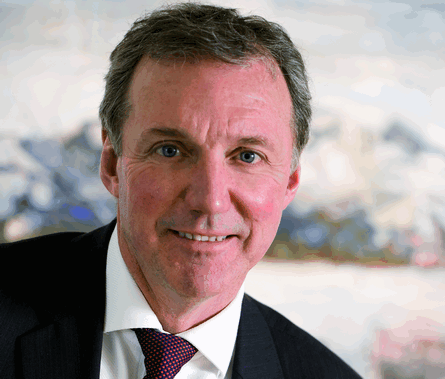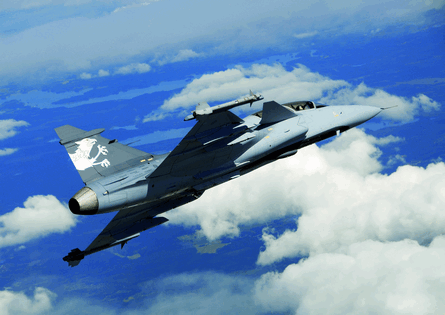Decisions loom in several competitions involving the Gripen fighter - in India, Norway, Switzerland and elsewhere - and Saab chief executive Åke Svensson makes no bones about their importance.
"It's a tremendous difference if we win all the contracts proposed for Gripen or if we win none of them," he says. "As you can imagine, the span there is enormous. It's digital on the military fighter field: either you win major business or you don't."
Saab's aeronautics business (which includes Gripen) accounts for 26% of business, with defence and security contributing 37% and products and systems 37%. However, the high level of Gripen work subcontracted within Saab means that the 26% figure understates its importance.
 |
|---|
© Saab |
"It gives maybe the feel that the aeronautics field is less and less important for Saab, and that is not true. I think that [aeronautics] will definitely be one of our cores for the long term."
On the all-critical Gripen decisions, optimism is tempered by caution. "The Gripen is providing a very competitive solution - it's cost-efficient and very, very advanced, and we are meeting those very, very tough requirements of Norway or Switzerland, for instance - but there is a political element also in the decision processes," says Svensson.
"It is very difficult to assess the final outcome. For planning purposes I think we are taking a rather conservative view that we would win one order in the coming couple of years and then maybe another order later. We are not assessing this as 'we will win everything', but I think it's fair to imagine that we will win some of this business. Depending on which business it is, it is a major difference." The big win would be India, where the requirement is for 126 aircraft.
Switching focus to defence and security, Svensson notes that the border between the two areas has become "rather diffuse", and that the growth of homeland security markets worldwide has created new applications for defence equipment developed to defend Swedish borders.
Among Saab's security products is the Civil Aircraft Missile Protection System, for which programme partner Naturelink Aviation recently became the launch customer, choosing to integrate it on the Embraer EMB-120. Saab is also marketing a redesigned Skeldar unmanned air vehicle, a maritime version of which is in development.
"We are seeking to concentrate our effort in the civil security field in protection of critical infrastructure on one hand and crisis management systems on the other hand," says Svensson.
"That requires everything from surveillance to communication command and control. For the critical infrastructure protection, where we have started has been nuclear power plants, airports and harbours. It has started with ground systems, but the next generation of these systems would also require airborne surveillance. These are, I think, growing opportunities [but] the customer segment is fragmented and unused to defence equipment. There will be a maturity process on the customer side."
BALANCING PRIORITIES
Of the third business unit, systems and products, Svensson says: "Here we see two elements: we can sell those products to the world market as standalone products - missiles, avionics systems, electronic warfare systems - but then also it supports our systems solutions: our Gripen fighter, our airborne early warning systems, etc." A delicate balancing of priorities is necessitated by the government's deepening reluctance to fund R&D.
Saab has learned to live with ongoing cuts to the national defence budget, but, as Svensson notes, the future trend in defence spending is unpredictable.
"With what has happened lately in Georgia, there's a debate starting in Sweden: will this mean that we will have to reconsider our budget for defence? I think it's too early to say. But I see some very interesting developments on the Nordic flank. Again, the borderline between defence and security is rather diffuse if you think about the oil and gas fields north of Scandinavia. These are important things to be able to protect, even in peacetime, so these are opportunities for new areas of industrial relations in the Nordic region."
 |
|---|
© Saab |
Acquisitions are also an element of Saab's international strategy. In 2006 it acquired the aerostructures business from South Africa's Denel, rebranding it Denel Saab Aerostructures. Its Linköping-based aerostructures operation, a risk-sharing partner in the A380 programme, is guided by a strategy of specialism in complex structures.
"We are not looking into areas where there are maybe 200 competitors in the world, because we cannot compete there. There are people out there who have lower salaries. But we have the Gripen production design technology in-house, so we have focused on wings and forward edges of wings, the engine attachment points...very difficult shapes."
Involvement in new Airbus and Boeing programmes helps to sustain Gripen development. "If we did not do Airbus and Boeing work, there's a risk that there would be too long a time gap between the design of Gripen and the structural redesign in 10 years' time.
The challenge is that it's risky, because we have seen both Boeing and Airbus being delayed, and the number of aircraft that they sell is not in our hands. Therefore we have to have a business case that is a little more conservative than Boeing and Airbus have. But on the other hand it's a long-term, stable business. Once they get into the production of the A380 and the 787, it will continue for 20 years or so, and that's good business for us to be part of. So it's challenging in the development phase,"
He acknowledges that Airbus and Boeing are tough customers. "They expect their suppliers to reduce their prices and share risk and be flexible in their production. As soon as they have a problem they expect their suppliers to stop production and wait for them when they need the deliveries next time."
Although Saab recently cut its target for organic sales growth this financial year from 5% to 3-4%, Svensson does not envisage near-term restructuring on a scale that ensued after defence electronics company Celsius was acquired in 1999. "We have the business units, but now we are in a continuous process - it's not like the focused thing that we did after the acquisition of Celsius, where we needed to make a major restructuring upfront. Now we are constantly working on adjustments to this. It may involve some acquisitions in the future. It may involve some divestitures."
Source: Flight International
















